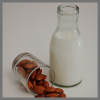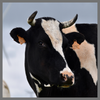-

Apr
06
Interpretive Summary: Total fishmeal replacement by defatted Tenebrio molitor larvae meal induces alterations in intermediary metabolism of European sea bass (Dicentrarchus labrax)

Insect meal has been increasingly considered as novel protein source in diets for different animal models, including fish. European sea bass is one of the most important fish species in Europe, particularly in the Mediterranean.
Read more
-

Apr
06
Interpretive Summary: Antimicrobial and antibiofilm activity of isoorientin against carbapenem non-sensitive Escherichia coli from raw milk of goats

Escherichia coli (E. coli) has been the major foodborne bacteria that can cause diarrhea, gastroenteritis, and some complications, and also used as fecal bacteria pollution indicator in food. Carbapenems are considered as the last resort to life-threatening E. coli infections.
Read more
-

Apr
06
Interpretive Summary: Dietary yeast beta 1,3/1,6 glucan supplemented to adult Labrador Retrievers alters peripheral blood immune cell responses to vaccination challenge without affecting protective immunity

Companion animal food trends reflect the growing demand for healthy, functional foods. Yeast-derived β-glucans have been shown to train the human immune system to respond and resolve inflammation quickly, which aligns with companion animal health goals of providing disease protection without excessive inflammation.
Read more
-

Apr
06
Interpretive Summary: Wet-food diet promotes the recovery from surgery of castration and control of body weight in adult young cats

Castration is a surgical operation common in pet cats and dogs, and weight gain is often observed a period after castration. Nutritional management can be important for animal health in both processes.
Read more
-

Apr
06
Interpretive Summary: Variations in the 24 h temporal patterns and time budgets of grazing, rumination, and idling behaviors in grazing dairy cows in a New Zealand system

This study explored how grazing dairy cows pattern their essential such as including grazing, rumination, and idling, and how they distribute their time for those behaviors over 24 h. We used a group of spring-calved grazing dairy cows affiliated with different breeds, milking ages, and genetic merits and recorded their grazing and rumination behaviors for the whole milking period.
Read more
-

Apr
06
Interpretive Summary: Analysis of runs of homozygosity of cattle living in different climate zones

Domestication and evolution of cattle originated different modern breeds in different places worldwide. The interaction between natural and artificial selection and the adaptation to environment shaped the genome, and the three different types of cattle here considered (taurus, indicus, and composite) may harbor different selection signatures.
Read more
-

Mar
29
DAIRY PRIDE Act of 2023 is introduced

As a response to the United States Food and Drug Administration’s (FDA’s) proposed guidance regarding labeling of non-dairy products, Senators Susan Collins (R-ME) and Angus King (I-ME) introduced The Defending Against Imitations and Replacements of Yogurt, milk, and cheese to Promote Regular Intake of Dairy Everyday Act (DAIRY PRIDE Act) of 2023. The DAIRY PRIDE Act would require non-dairy products made from nuts, seeds, plants, and algae to no longer be mislabeled with terms such as milk, yogurt, or cheese.
Read more
-

Mar
29
FDA releases guidance for plant-based milk-alternative beverage labeling

The United States Food and Drug Administration (FDA) has released a set of guidelines for plant-based milk-alternative beverage labeling. The guidance also includes recommendations on the use of voluntary nutrient statements. According to the FDA, the use of these voluntary nutrient statements would provide consumers with additional nutrition information to help them understand certain nutritional differences between these products and milk and make informed dietary choices.
Read more
-

Mar
29
FSIS extends time-limited trials until November

The United States Department of Agriculture’s (USDA’s) Food and Safety Inspection Service (FSIS) has extended the trial period for a study on the impact that line speeds have on workers at swine processing facilities, until November 30, 2023.
Read more
-

Mar
29
Industry groups all to modernize the Federal Milk Marketing Order system

The Board of Directors of the National Milk Producers Federation (NMPF) has endorsed a proposal that will modernize the Federal Milk Marketing Order (FMMO) system. Overseen by the United States Department of Agriculture (USDA), FMMOs establish provisions under which dairy processors buy fresh milk from dairy farmers who supply a marketing area, maintaining stable marketing relationships for all handlers and producers and organizing the complex process of marketing fresh milk.
Read more
-

Mar
29
New “Product of USA” rule put forth by Biden Administration

The United States Department of Agriculture (USDA) has proposed new requirements for the voluntary “Product of USA” claim. The proposed rule allows the voluntary “Product of USA” or “Made in the USA” label claim to be used on meat, poultry, and egg products only when they are derived from animals born, raised, slaughtered, and processed in the United States.
Read more
-

Mar
29
The Beagle Brigade Act of 2023 is introduced

Earlier this month, United States Senators Reverend Raphael Warnock (D-GA) and Joni Ernst (R-IA) introduced the Beagle Brigade Act of 2023. The bipartisan bill would provide permanent authorization for the National Detector Dog Training Center, located in Newnan, Georgia.
Read more
-

Mar
29
The Military Family Nutrition Access Act is introduced

United States Senators Tammy Duckworth (D-IL), and Lisa Murkowski (R-AK) have introduced The Military Family Nutrition Access Act, to support active-duty military families experiencing food insecurity. The bipartisan bill would address food insecurity by excluding Basic Allowance for Housing (BAH), from income calculations used to determine Supplemental Nutrition Assistance Program (SNAP) eligibility.
Read more
-

Mar
29
US requests talks with Mexico over GMO corn

The Office of the United States Trade Representative (USTR) has announced that it is requesting technical consultations with the Government of Mexico under the Sanitary and Phytosanitary Measures (SPS) Chapter of the United States–Mexico–Canada Agreement (USMCA). The request comes as the United States and Mexico are at battle regarding genetically modified corn.
Read more
-

Mar
29
USDA announces over 43 million dollars for meat and poultry research

The United States Department of Agriculture (USDA) has announced over $43 million for meat and poultry processing research, innovation, and expansion. This funding comes as part of the American Rescue Plan and the USDA’s Agriculture and Food Research Initiative (AFRI).
Read more
-

Mar
29
USDA Secretary Tom Vilsack releases statement on FY2024

President Joe Biden has released the Fiscal Year 2024 (FY2024) budget. The President’s plan calls for increasing corporate taxes and income taxes on higher-income earners (over $400,000) to shave the growth of the national debt over the next decade.
Read more
-

Mar
23
Interpretive Summary: Effects of Aspergillus oryzae prebiotic on animal performance, nutrients digestibility, and feeding behavior of backgrounding beef heifers fed with either a sorghum silage- or a byproducts-based diet

This experiment evaluated the effects of the dietary inclusion or not of Aspergillus oryzae prebiotic (AOP; 2 g/d) in two contrasting diets: sorghum silage-based (SS) vs. byproducts-based (BP), on growth performance, nutrient digestibility, and feeding behavior of growing heifers.
Read more
-

Mar
23
Interpretive Summary: Feeding a Saccharomyces cerevisiae fermentation product before and during a feed restriction challenge on milk production, plasma biomarkers, and immune function in Holstein cows

Postbiotic fermentation products have the potential to improve health and support anti-inflammatory functions when fed to lactating dairy cows. Since dairy cows experience disruptions of the intestinal barrier function at various stages of their life, for example, the transition into lactation, we sought to investigate potential beneficial effects of feeding a Saccharomyces cerevisiae fermentation (NTK) before and during a period of feed restriction to challenge gut function.
Read more
-

Mar
23
Interpretive Summary: Feeding thermally processed spray-dried egg whites, singly or in combination with 15-acetyldeoxynivalenol or peroxidized soybean oil on growth performance, digestibility, intestinal morphology, and oxidative status in nursery pigs

Swine can be exposed to a variety of nutritional stressors that can affect their well-being and productivity. Three stressors of concern include grains with naturally occurring mycotoxins, oxidized proteins in feedstuffs due to overheating during processing, or lipids that have been damaged by excessive heating.
Read more
-

Mar
23
Interpretive Summary: Effects of cottonseed meal on performance, gossypol residue, liver function, lipid metabolism, and cecal microbiota in geese

The shortage of feed resources and the rising price have become one of the significant challenges for animal husbandry worldwide. Considering the strong tolerance and adaptability to roughage of geese, less expensive crop byproducts are used in goose feed by animal nutritionists.
Read more
 AprInterpretive Summary: Total fishmeal replacement by defatted Tenebrio molitor larvae meal induces alterations in intermediary metabolism of European sea bass (Dicentrarchus labrax)
AprInterpretive Summary: Total fishmeal replacement by defatted Tenebrio molitor larvae meal induces alterations in intermediary metabolism of European sea bass (Dicentrarchus labrax) Insect meal has been increasingly considered as novel protein source in diets for different animal models, including fish. European sea bass is one of the most important fish species in Europe, particularly in the Mediterranean.
Insect meal has been increasingly considered as novel protein source in diets for different animal models, including fish. European sea bass is one of the most important fish species in Europe, particularly in the Mediterranean. AprInterpretive Summary: Antimicrobial and antibiofilm activity of isoorientin against carbapenem non-sensitive Escherichia coli from raw milk of goats
AprInterpretive Summary: Antimicrobial and antibiofilm activity of isoorientin against carbapenem non-sensitive Escherichia coli from raw milk of goats Escherichia coli (E. coli) has been the major foodborne bacteria that can cause diarrhea, gastroenteritis, and some complications, and also used as fecal bacteria pollution indicator in food. Carbapenems are considered as the last resort to life-threatening E. coli infections.
Escherichia coli (E. coli) has been the major foodborne bacteria that can cause diarrhea, gastroenteritis, and some complications, and also used as fecal bacteria pollution indicator in food. Carbapenems are considered as the last resort to life-threatening E. coli infections. AprInterpretive Summary: Dietary yeast beta 1,3/1,6 glucan supplemented to adult Labrador Retrievers alters peripheral blood immune cell responses to vaccination challenge without affecting protective immunity
AprInterpretive Summary: Dietary yeast beta 1,3/1,6 glucan supplemented to adult Labrador Retrievers alters peripheral blood immune cell responses to vaccination challenge without affecting protective immunity Companion animal food trends reflect the growing demand for healthy, functional foods. Yeast-derived β-glucans have been shown to train the human immune system to respond and resolve inflammation quickly, which aligns with companion animal health goals of providing disease protection without excessive inflammation.
Companion animal food trends reflect the growing demand for healthy, functional foods. Yeast-derived β-glucans have been shown to train the human immune system to respond and resolve inflammation quickly, which aligns with companion animal health goals of providing disease protection without excessive inflammation. AprInterpretive Summary: Wet-food diet promotes the recovery from surgery of castration and control of body weight in adult young cats
AprInterpretive Summary: Wet-food diet promotes the recovery from surgery of castration and control of body weight in adult young cats Castration is a surgical operation common in pet cats and dogs, and weight gain is often observed a period after castration. Nutritional management can be important for animal health in both processes.
Castration is a surgical operation common in pet cats and dogs, and weight gain is often observed a period after castration. Nutritional management can be important for animal health in both processes. AprInterpretive Summary: Variations in the 24 h temporal patterns and time budgets of grazing, rumination, and idling behaviors in grazing dairy cows in a New Zealand system
AprInterpretive Summary: Variations in the 24 h temporal patterns and time budgets of grazing, rumination, and idling behaviors in grazing dairy cows in a New Zealand system This study explored how grazing dairy cows pattern their essential such as including grazing, rumination, and idling, and how they distribute their time for those behaviors over 24 h. We used a group of spring-calved grazing dairy cows affiliated with different breeds, milking ages, and genetic merits and recorded their grazing and rumination behaviors for the whole milking period.
This study explored how grazing dairy cows pattern their essential such as including grazing, rumination, and idling, and how they distribute their time for those behaviors over 24 h. We used a group of spring-calved grazing dairy cows affiliated with different breeds, milking ages, and genetic merits and recorded their grazing and rumination behaviors for the whole milking period. AprInterpretive Summary: Analysis of runs of homozygosity of cattle living in different climate zones
AprInterpretive Summary: Analysis of runs of homozygosity of cattle living in different climate zones Domestication and evolution of cattle originated different modern breeds in different places worldwide. The interaction between natural and artificial selection and the adaptation to environment shaped the genome, and the three different types of cattle here considered (taurus, indicus, and composite) may harbor different selection signatures.
Domestication and evolution of cattle originated different modern breeds in different places worldwide. The interaction between natural and artificial selection and the adaptation to environment shaped the genome, and the three different types of cattle here considered (taurus, indicus, and composite) may harbor different selection signatures. MarDAIRY PRIDE Act of 2023 is introduced
MarDAIRY PRIDE Act of 2023 is introduced As a response to the United States Food and Drug Administration’s (FDA’s) proposed guidance regarding labeling of non-dairy products, Senators Susan Collins (R-ME) and Angus King (I-ME) introduced The Defending Against Imitations and Replacements of Yogurt, milk, and cheese to Promote Regular Intake of Dairy Everyday Act (DAIRY PRIDE Act) of 2023. The DAIRY PRIDE Act would require non-dairy products made from nuts, seeds, plants, and algae to no longer be mislabeled with terms such as milk, yogurt, or cheese.
As a response to the United States Food and Drug Administration’s (FDA’s) proposed guidance regarding labeling of non-dairy products, Senators Susan Collins (R-ME) and Angus King (I-ME) introduced The Defending Against Imitations and Replacements of Yogurt, milk, and cheese to Promote Regular Intake of Dairy Everyday Act (DAIRY PRIDE Act) of 2023. The DAIRY PRIDE Act would require non-dairy products made from nuts, seeds, plants, and algae to no longer be mislabeled with terms such as milk, yogurt, or cheese. MarFDA releases guidance for plant-based milk-alternative beverage labeling
MarFDA releases guidance for plant-based milk-alternative beverage labeling The United States Food and Drug Administration (FDA) has released a set of guidelines for plant-based milk-alternative beverage labeling. The guidance also includes recommendations on the use of voluntary nutrient statements. According to the FDA, the use of these voluntary nutrient statements would provide consumers with additional nutrition information to help them understand certain nutritional differences between these products and milk and make informed dietary choices.
The United States Food and Drug Administration (FDA) has released a set of guidelines for plant-based milk-alternative beverage labeling. The guidance also includes recommendations on the use of voluntary nutrient statements. According to the FDA, the use of these voluntary nutrient statements would provide consumers with additional nutrition information to help them understand certain nutritional differences between these products and milk and make informed dietary choices. MarFSIS extends time-limited trials until November
MarFSIS extends time-limited trials until November The United States Department of Agriculture’s (USDA’s) Food and Safety Inspection Service (FSIS) has extended the trial period for a study on the impact that line speeds have on workers at swine processing facilities, until November 30, 2023.
The United States Department of Agriculture’s (USDA’s) Food and Safety Inspection Service (FSIS) has extended the trial period for a study on the impact that line speeds have on workers at swine processing facilities, until November 30, 2023. MarIndustry groups all to modernize the Federal Milk Marketing Order system
MarIndustry groups all to modernize the Federal Milk Marketing Order system The Board of Directors of the National Milk Producers Federation (NMPF) has endorsed a proposal that will modernize the Federal Milk Marketing Order (FMMO) system. Overseen by the United States Department of Agriculture (USDA), FMMOs establish provisions under which dairy processors buy fresh milk from dairy farmers who supply a marketing area, maintaining stable marketing relationships for all handlers and producers and organizing the complex process of marketing fresh milk.
The Board of Directors of the National Milk Producers Federation (NMPF) has endorsed a proposal that will modernize the Federal Milk Marketing Order (FMMO) system. Overseen by the United States Department of Agriculture (USDA), FMMOs establish provisions under which dairy processors buy fresh milk from dairy farmers who supply a marketing area, maintaining stable marketing relationships for all handlers and producers and organizing the complex process of marketing fresh milk. MarNew “Product of USA” rule put forth by Biden Administration
MarNew “Product of USA” rule put forth by Biden Administration The United States Department of Agriculture (USDA) has proposed new requirements for the voluntary “Product of USA” claim. The proposed rule allows the voluntary “Product of USA” or “Made in the USA” label claim to be used on meat, poultry, and egg products only when they are derived from animals born, raised, slaughtered, and processed in the United States.
The United States Department of Agriculture (USDA) has proposed new requirements for the voluntary “Product of USA” claim. The proposed rule allows the voluntary “Product of USA” or “Made in the USA” label claim to be used on meat, poultry, and egg products only when they are derived from animals born, raised, slaughtered, and processed in the United States. MarThe Beagle Brigade Act of 2023 is introduced
MarThe Beagle Brigade Act of 2023 is introduced Earlier this month, United States Senators Reverend Raphael Warnock (D-GA) and Joni Ernst (R-IA) introduced the Beagle Brigade Act of 2023. The bipartisan bill would provide permanent authorization for the National Detector Dog Training Center, located in Newnan, Georgia.
Earlier this month, United States Senators Reverend Raphael Warnock (D-GA) and Joni Ernst (R-IA) introduced the Beagle Brigade Act of 2023. The bipartisan bill would provide permanent authorization for the National Detector Dog Training Center, located in Newnan, Georgia. MarThe Military Family Nutrition Access Act is introduced
MarThe Military Family Nutrition Access Act is introduced United States Senators Tammy Duckworth (D-IL), and Lisa Murkowski (R-AK) have introduced The Military Family Nutrition Access Act, to support active-duty military families experiencing food insecurity. The bipartisan bill would address food insecurity by excluding Basic Allowance for Housing (BAH), from income calculations used to determine Supplemental Nutrition Assistance Program (SNAP) eligibility.
United States Senators Tammy Duckworth (D-IL), and Lisa Murkowski (R-AK) have introduced The Military Family Nutrition Access Act, to support active-duty military families experiencing food insecurity. The bipartisan bill would address food insecurity by excluding Basic Allowance for Housing (BAH), from income calculations used to determine Supplemental Nutrition Assistance Program (SNAP) eligibility. MarUS requests talks with Mexico over GMO corn
MarUS requests talks with Mexico over GMO corn The Office of the United States Trade Representative (USTR) has announced that it is requesting technical consultations with the Government of Mexico under the Sanitary and Phytosanitary Measures (SPS) Chapter of the United States–Mexico–Canada Agreement (USMCA). The request comes as the United States and Mexico are at battle regarding genetically modified corn.
The Office of the United States Trade Representative (USTR) has announced that it is requesting technical consultations with the Government of Mexico under the Sanitary and Phytosanitary Measures (SPS) Chapter of the United States–Mexico–Canada Agreement (USMCA). The request comes as the United States and Mexico are at battle regarding genetically modified corn. MarUSDA announces over 43 million dollars for meat and poultry research
MarUSDA announces over 43 million dollars for meat and poultry research The United States Department of Agriculture (USDA) has announced over $43 million for meat and poultry processing research, innovation, and expansion. This funding comes as part of the American Rescue Plan and the USDA’s Agriculture and Food Research Initiative (AFRI).
The United States Department of Agriculture (USDA) has announced over $43 million for meat and poultry processing research, innovation, and expansion. This funding comes as part of the American Rescue Plan and the USDA’s Agriculture and Food Research Initiative (AFRI). MarUSDA Secretary Tom Vilsack releases statement on FY2024
MarUSDA Secretary Tom Vilsack releases statement on FY2024 President Joe Biden has released the Fiscal Year 2024 (FY2024) budget. The President’s plan calls for increasing corporate taxes and income taxes on higher-income earners (over $400,000) to shave the growth of the national debt over the next decade.
President Joe Biden has released the Fiscal Year 2024 (FY2024) budget. The President’s plan calls for increasing corporate taxes and income taxes on higher-income earners (over $400,000) to shave the growth of the national debt over the next decade. MarInterpretive Summary: Effects of Aspergillus oryzae prebiotic on animal performance, nutrients digestibility, and feeding behavior of backgrounding beef heifers fed with either a sorghum silage- or a byproducts-based diet
MarInterpretive Summary: Effects of Aspergillus oryzae prebiotic on animal performance, nutrients digestibility, and feeding behavior of backgrounding beef heifers fed with either a sorghum silage- or a byproducts-based diet This experiment evaluated the effects of the dietary inclusion or not of Aspergillus oryzae prebiotic (AOP; 2 g/d) in two contrasting diets: sorghum silage-based (SS) vs. byproducts-based (BP), on growth performance, nutrient digestibility, and feeding behavior of growing heifers.
This experiment evaluated the effects of the dietary inclusion or not of Aspergillus oryzae prebiotic (AOP; 2 g/d) in two contrasting diets: sorghum silage-based (SS) vs. byproducts-based (BP), on growth performance, nutrient digestibility, and feeding behavior of growing heifers. MarInterpretive Summary: Feeding a Saccharomyces cerevisiae fermentation product before and during a feed restriction challenge on milk production, plasma biomarkers, and immune function in Holstein cows
MarInterpretive Summary: Feeding a Saccharomyces cerevisiae fermentation product before and during a feed restriction challenge on milk production, plasma biomarkers, and immune function in Holstein cows Postbiotic fermentation products have the potential to improve health and support anti-inflammatory functions when fed to lactating dairy cows. Since dairy cows experience disruptions of the intestinal barrier function at various stages of their life, for example, the transition into lactation, we sought to investigate potential beneficial effects of feeding a Saccharomyces cerevisiae fermentation (NTK) before and during a period of feed restriction to challenge gut function.
Postbiotic fermentation products have the potential to improve health and support anti-inflammatory functions when fed to lactating dairy cows. Since dairy cows experience disruptions of the intestinal barrier function at various stages of their life, for example, the transition into lactation, we sought to investigate potential beneficial effects of feeding a Saccharomyces cerevisiae fermentation (NTK) before and during a period of feed restriction to challenge gut function. MarInterpretive Summary: Feeding thermally processed spray-dried egg whites, singly or in combination with 15-acetyldeoxynivalenol or peroxidized soybean oil on growth performance, digestibility, intestinal morphology, and oxidative status in nursery pigs
MarInterpretive Summary: Feeding thermally processed spray-dried egg whites, singly or in combination with 15-acetyldeoxynivalenol or peroxidized soybean oil on growth performance, digestibility, intestinal morphology, and oxidative status in nursery pigs Swine can be exposed to a variety of nutritional stressors that can affect their well-being and productivity. Three stressors of concern include grains with naturally occurring mycotoxins, oxidized proteins in feedstuffs due to overheating during processing, or lipids that have been damaged by excessive heating.
Swine can be exposed to a variety of nutritional stressors that can affect their well-being and productivity. Three stressors of concern include grains with naturally occurring mycotoxins, oxidized proteins in feedstuffs due to overheating during processing, or lipids that have been damaged by excessive heating. MarInterpretive Summary: Effects of cottonseed meal on performance, gossypol residue, liver function, lipid metabolism, and cecal microbiota in geese
MarInterpretive Summary: Effects of cottonseed meal on performance, gossypol residue, liver function, lipid metabolism, and cecal microbiota in geese The shortage of feed resources and the rising price have become one of the significant challenges for animal husbandry worldwide. Considering the strong tolerance and adaptability to roughage of geese, less expensive crop byproducts are used in goose feed by animal nutritionists.
The shortage of feed resources and the rising price have become one of the significant challenges for animal husbandry worldwide. Considering the strong tolerance and adaptability to roughage of geese, less expensive crop byproducts are used in goose feed by animal nutritionists.



